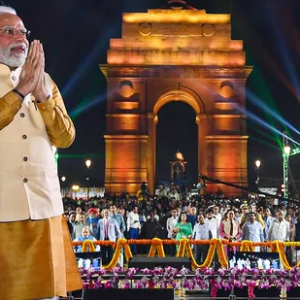India Ocean is destined to define the future of the world. Sri Lanka, located enviably in the
centre of the Indian Ocean is well poised to play a significant role in determining this future. Our shores are washed by the waters of this great ocean. It has shaped us as a distinct people. Our future development is intrinsically linked to it and we share responsibility in keeping its waters safe. We believe, as people of the Indian Ocean, “Peace, Progress and Prosperity” are goals that need to be pursued together. We will continue to take a leading role, in bringing our partners in the Indian Ocean together to deliberate on issues of importance to all of us.
We are meeting at a time when global and financial economic power shifts point towards Asia. The global economic power rebalance – away from the established advanced economies in North America, Europe and Japan, will continue well into the latter part of the century. Economic dominance, technology and military might, the basis of political power in the West has eroded to a significant extent by the extraordinary economic development of Asia in the last 50 years. The ‘HSBC World in Forecast 2050’ forecasts 19 countries from Asia to be the largest economies by 2050. By 2030 Asia is expected to surpass the West in terms of global power, based on population, GDP, technology and military spending. It is also estimated that, by that time, the unipolar world would be replaced by a multipolar one with USA, China, India, Germany, Japan and Russia positioned as key players.
These predictions are reassured by the recent Price Water House Coopers (PWC) Report: World in 2050. It concludes that 13 (Vietnam, Bangladesh, India, Philippines, Indonesia, Pakistan, Malaysia, Thailand, China, Saudi Arabia, Australia, Iran) out of 32 countries predicted to be leading economies of the world, will be from the Indian Ocean Region. This reality will increase our strategic importance in the globe.
In practical terms, some countries in Asia have already taken over the advanced Western countries in purchasing power parity. Despite projected slowdown, it is predicted that the Chinese economy will supersede the US economy by 2028. India has shown great potential to become the second largest economy in the world in terms of Purchasing Power Parity by 2050. Indonesia, Malaysia and Vietnam are also predicted to achieve remarkable rates in economic growth and to have great potential to take over some of the western countries in the Purchasing Power Parity by 2030. As a region, ASEAN is poised to cover thirty percent of the global GDP, once the Regional Comprehensive Economic Partnership Agreement among the ASEAN countries is concluded.
Despite these promising predictions, intra trade in the Indian Ocean and the Bay of Bengal as well as East Asia remains historically low. South Asia remains the least economically integrated region in the world. Intra-regional trade accounts for only 5 percent of South Asia’s total trade, compared to 25 percent in ASEAN. Intra-regional investment is smaller than 1 percent of overall investment. There are several reasons for this setback. They stem from gaps in our policy infrastructure, mistrust and political tension among major countries, and mindset of certain communities. The Bay of Bengal will be in the strategic spotlight as one of the key transit zones between the Indian and Pacific regions and the pivotal points for maritime security across the Indo Pacific littorals. However, if we could overcome these challenges, the current trade volume of USD 28 billion could grow up to USD 100 billion only in South Asia. In future, the South East Asia economies put together, its minimum viable economic power and its trade volume will be bigger than that of North American Free Trade Agreement.
Regrettably, we are yet to workout multilateral agreements to promote trade in this region. In the circumstances, bilateral trade agreements between littoral countries will substitute Regional Intra Trade. The Government of Sri Lanka has decided to enter into bilateral agreements with the neighboring littoral states without waiting for regional arrangements to be finalized.
We have already entered into Free Trade Agreements with India and Pakistan. We are in the process of deepening our FTA with India to enable greater cooperation. We will finalize a FTA with Singapore and commence negotiations with other littoral states. We are also planning to engage with other countries in the Bay of Bengal Region through Free Trade Agreements so that we reap the benefits of economic potential of the Bay in the future. We will also expand the FTA with Pakistan.
Sri Lanka’s development as a shipping, air and business hub will contribute to the development of intra regional trade. I trust that the Economic growth in our region can only be accelerated by increasing intra regional trade and infrastructure development for connectivity. It should aim at creating a route to enter into global value chain by creating a regional value chain. This will provide the opportunity for countries such as Sri Lanka to indentify tradable factors in our national economy. Development of infrastructure and connectivity will not be sufficient for Sri Lanka to enhance its trade. We need our governments to commit fully to multilateral trading in order to enhance intra regional trade development. These include:
- Preventing protectionist trade measures
- Implementing ease of doing business measures
- Commitment to the WTO Trade Facilitation Agreement
- Removing high tariffs – para tariffs and non tariff barriers over agreed time period.
As Indian Ocean partners we can build a policy infrastructure to improve the regional intra trade. We invite one of the Indian Ocean littoral States to host the first meeting of interested littoral states on developing a “Policy framework to promote Intra Regional Trade within an agreed time period.”
Businesses in the Region must grow for intra-regional trade to develop. These Businesses require capital for expansion, which is a scarce commodity. The establishment of an Indian Ocean Development Fund will make such financing available. The Fund will make financial facilities available to National Development Banks which promote growth and expansion by providing capital. To this end, one of the options is to establish a Development Financing Institute for business expansion in the region.
China’s One Belt One Road Initiative (OBOR) is a tool for our development. China announced the concept back in 2013, and we see after four years it has gained significant economic momentum. OBOR connects Asia, Europe and Africa, and passes through more than 65 countries and regions with a population of about 4.4 billion and a third of the global economy. In Sri Lanka’s view this initiative serves as a platform for member countries of OBOR to contribute to the global value chain. The OBOR has added fresh impetus to China and the rest of the world to promote regional cooperation and presented numerous opportunities for foreign companies to be involved.
Japan’s “Free and Open Indo-Pacific Strategy”, which is an evolution and development of the idea of the “Confluence of the Two Seas”, will also be a channel for creating a broad region. The “Free and Open Indo-Pacific Strategy” foresees a broad region connecting two oceans – the Pacific and Indian Oceans, will include both Asia and Africa. It is designed to promote stability and prosperity of this region as a whole. Sri Lanka sees growing convergence of ideas in terms of maritime cooperation between the Indo-Pacific regions will also derive economic benefits to the Indian Ocean region.
The vital Sea Lanes of Communication in the Indian Ocean that fuels the global economy needs to be open for all and must be used for mutual benefit in a sustainable manner. It is essential to maintain peace and stability in the Indian Ocean Region which will ensure rights of all states to the freedom of navigation and over flight and unhindered lawful maritime commerce are conducted in keeping with current international laws and regulations. In terms of Maritime build up taking place in the Indian Ocean, we see major players such as India, Australia, USA, China, and Japan envisaging various projects ranging from ocean excavation to placing remote sensors for ocean research. The latter three having their forward naval presence, will play a greater role in maritime affairs. This will also lead to Naval power competitions, which will foresee sea control as well as denials on navigation.
There are 10 critical choke points in the Indian Ocean that remain vulnerable to air and maritime encounters and possible terrorist attacks by non-state actors. Given the rising conflicts in the Middle East and West Asia, world’s major powers have deployed substantial military forces in the Indian Ocean Region. This trend will continue to be same at least for some more decades until such time that the world community gets together and resolve causes for these conflicts.
These traditional and modern security concerns are yet to be addressed internationally. Articles 34 – 56 of UNCLOS are insufficient to deal with the concerns that are related to freedom of navigation in the Indian ocean. Therefore, Sri Lanka intends working with all its partners in creating a shared vision for economic and security engagement. A code of conduct that ensures the freedom of navigation in this Ocean will be an essential component of this vision. In this regard, Sri Lanka will soon commence exploratory discussions on convening a meeting to deliberate on a stable legal order on freedom of navigation and over flight in the Indian Ocean. Taking such a course of action will enable the littoral states to take the initiative to manage competition and determine our own fate.
Maintaining the freedom of navigation is of paramount importance for Sri Lanka to become the hub in the Indian Ocean. It is only then that this country will be able to reap the full benefits of strategic location as well as the availability of ports on all coasts and two international airports with good land connectivity. The air and sea connectivity will naturally promote logistics. Colombo will also be a center for offshore finance and business. Finally Sri Lanka will offer a platform as a manufacturing and service hub enjoying preferential access to the EU markets.
Sri Lanka decided to develop the ports, especially the Hambantota port which some claim to be a military base. Sri Lanka does not enter into military alliances with any country or make bases available to foreign countries in its ports or airports. It will continue military cooperation such as training, supply of equipment and taking part in joint exercises with friendly countries. Only the Sri Lanka Armed Forces have the responsibility for military activity in its ports and airports. We are also working with foreign private investors on the commercial development of our ports.
Sri Lanka is open to trade with all its partners. We aim to become as in the past, a destination of choice for all those looking to tap in to the potential of the Indian Ocean. I look forward to engaging with all interested littoral states in creating a “policy framework to promote intra regional trade within a time line” so that economic activity in the Indian Ocean region can be enhanced. We intend taking leading role in initiating a legal order in the Indian Ocean to ensure freedom of navigation. It is our belief that if we all work for these common objectives, sustainable peace and prosperity in our region can be undoubtedly achieved.
*This article is a summary of the speech delivered by Shri Ranil Wickremesinghe,Prime Minister of Sri Lanka on 31st August, 2017 at the 2nd Indian Ocean Conference at Colombo, Sri Lanka organised by India Foundation.
(This article is carried in the print edition of November-December 2017 issue of India Foundation Journal.)



